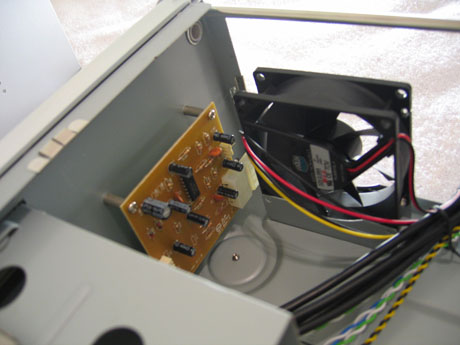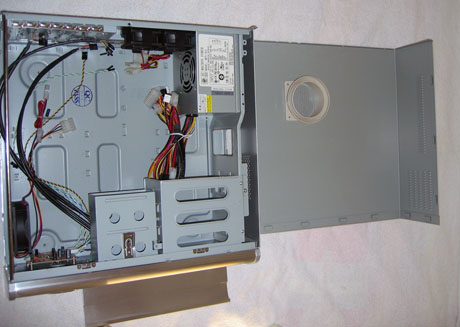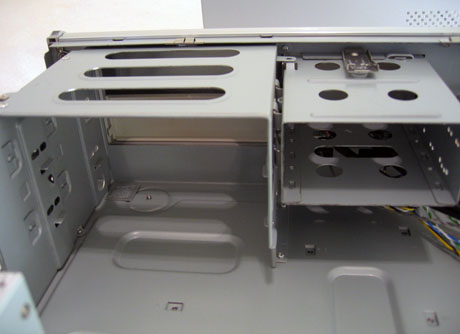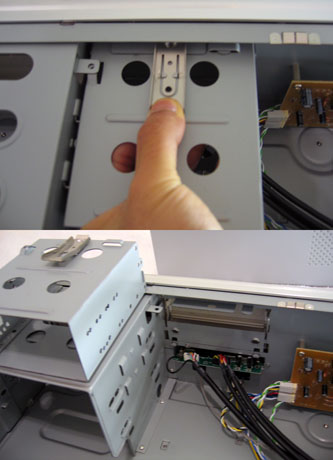December 2004 HTPC Case Roundup
by Purav Sanghani on December 27, 2004 2:00 AM EST- Posted in
- Cases/Cooling/PSUs
CoolerMaster Cavalier 2 (cont'd)
To remove the cover, we need to remove three screws at the back, then slide the cover back about an inch and lift up. Though not as tedious as the six screws that we dealt with on the D.Vine 5, we would like to see thumbscrews replace the standard ones. This can also be done by the user.Internal Design
Looking at the underside of the top cover, we see the vent that we noticed before opening up the Cavalier 2. There is also a circular duct, which will guide fresh air from the outside directly to the CPU heatsink fan. No matter the external temperature, the CPU will receive an "untouched", and definitely cooler supply of air.We took one look at the design of the chassis and realized it was almost exactly like the D.Vine 4 with a few minor variations. First, the 5-1/4" drive bays sit at the right of the chassis. To the right of those, however, we see a wall that splits the rest of the case from an inch wide section, which contains an extra 3-1/2" drive bay mount for a HDD.
Second, a removable dual 3-1/2" drive cage is placed in the same spot as on the D.Vine 4, but CoolerMaster has decided to make it even easier to remove by installing a tool-less device here. All we need to do is push down on the flexible steel clip and pull the drive cage back. There is also a tab with a screw hole to secure the cage further. We were disappointed that they made these bays external instead of HDD applications. A single external bay would have been more than sufficient, even if used as only a desktop PC.
To the left of the drive bays, we see the circuit board for the sound meter, as well as an 80mm fan mounted on the left side of the case where we saw the vent on the Cavalier's shell. This is an intake fan and blows air at the side of the 3-1/2" drive cage.
The motherboard tray in the Cavalier 2, like the D.Vine 5, supports both ATX and uATX boards as we see in the picture. There are plenty of holes available to use the screw-in stand-offs.
The expansion card slots, again like the D.Vine 5, are not tool-less, but then also again, we should not expect any of these features to be implemented in HTPC cases just yet.
Cooling
With the addition of an 80mm on the side, the Cavalier matches the D.Vine 5 with dual 60mm fans at the back behind the CPU area. Both are mounted as exhausts and help create a system that moves air from the front left side and out through the back.
The CPU duct that we mentioned earlier will also assist in bringing in air from the outside especially for the CPU heatsink. This should help cool the CPU by a few degrees.
CoolerMaster also includes a proprietary 300W Macron Power PSU, model MPT-301, which supports two SATA drives, four standard drives (MOLEX), two floppy drives, and also has a 6-pin P4 connector.
Construction
Since the Cavalier's body is made of steel, we searched for sharp edges around the inside. We did find a few around the drive bays and we advise users to take care during drive installations.Using steel will ultimately keep the price of the Cavalier 2 down, well below that of the D.Vine 5 in the end.














34 Comments
View All Comments
monsoon - Wednesday, September 7, 2005 - link
hola,i want my HTPC to be a full fledged double-core AMD PC capable of running everything, with double 5'25" front bays and silent.
so, what'S out there today to realize such a project ?
it's been almost a year since this shoot-out, and i would really love to see some commercial products ( already assembled or cases only ) to match these needs.
120mm fans anyone ?
passive cooling ( or should we wait for the coming laptop double-core CPU releases ) ?
thanks for reading this,
cheers
rdunnill - Friday, January 28, 2005 - link
Quote: "There isn't anything requiring these large cases except a gaming video card"To the contrary, I use a Holo3Dgraph-I deinterlacing card, which is full-height and thus requires a modestly-footprinted case like the NMediaPC.
rdunnill - Friday, January 28, 2005 - link
I am considering the NMediaPC case due to its small footprint.Footprint barely received mention in the review, but it's important to me, because the space in my HT cabinet is small.
mindless1 - Thursday, December 30, 2004 - link
JKing76, the distinction is not "just playing movies". There isn't anything requiring these large cases except a gaming video card, or to look at it another way, stuffing so many cards in that you can't get a riser to work and need a larger power supply too. Perhaps if you need more than 2 HDDs, that's an issue too... but most won't.Games <> Home Theater
Some can't grasp that, and that's OK, there SHOULD be cases suitable for building living room gaming boxes, but that does not begin to mean HTPC cases per se, should be this large.
goku21 - Thursday, December 30, 2004 - link
What about doing a project/review on a HTPC you build yourself? Go all out and instead of using a HTPC case use a SFF case or something. Be a little different about it.That's something I'd like to see. Perhaps something interactive where all the readers can vote on what types of components go into it and what not.
Of course that's just my stupid opinion =)
PuravSanghani - Wednesday, December 29, 2004 - link
We gave our Editor's Choice Award to the SilverStone LC10/M because it has a combination of great features (VFD Text display, room for expansion with more HDD mounting space, the ability to install a full ATX board and power supply, as well as an optional multimedia kit since MS Windows Media Center is not sold on store shelves just yet). Bias is not one of the reasons we chose the LC10.The HTPC100 is a great out-of-the-box solution if you want a simple barebones system. It performed well in our thermal and sound benchmarks. The case, however, does not have much room for expansion, only supports microATX boards, and does not have a text display. Although, for its performance in thermal and sound we believe it is a worthy competitor to the LC10.
We hope this clears up some confusion in our regarding our conclusion of this roundup.
-----
Nintari, Mindless, mcveigh: We chose these components because many boxed Home Theater PCs come with hardware similar to our configuration. A media center PC, in our definition, is not just a PC with a TV Tuner slapped in it, but rather a fully functional PC with the ability to process home theater content.
Definitions of the HTPC will vary by user and the purpose of the HTPC in their home theater setup.
During our testing we do not install a TV Tuner card but we do process content like playing a DVD and video games to simulate operations during normal PC use with this "standard" hardware.
-----
#27: Feel free to let us know of any errors in the article and we will be more than happy to fix them. Thanks.
Purav Sanghani
Clint - Wednesday, December 29, 2004 - link
All three vendor links for the Silverstone case show a completely different case (though they all match one another).ElFenix - Tuesday, December 28, 2004 - link
I've asked for years: please hire an english major to edit your articles. The sentence structure of this article is even worse than most of the articles around here.JKing76 - Tuesday, December 28, 2004 - link
Sorry mindless, I don't buy your definition of HTPC. I consider an HTPC to be a computer you'd keep hooked up to a home theater system full time. You want a tiny, low-power PC just for playing movies, well, that's your choice. But there's no reason big screen, high-quality surround sound gaming support can't be part of a HTPC.geogecko - Tuesday, December 28, 2004 - link
Personally...the best HTPC case money can buy...http://www.atechfabrication.com/products/heatsync_...